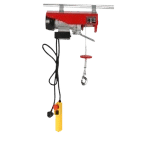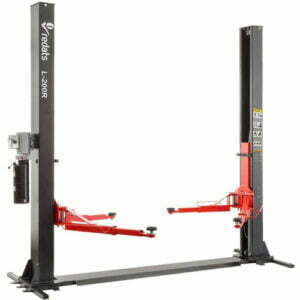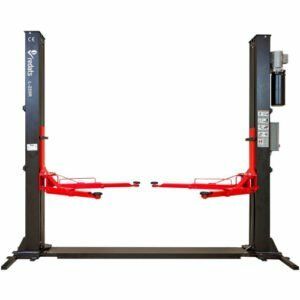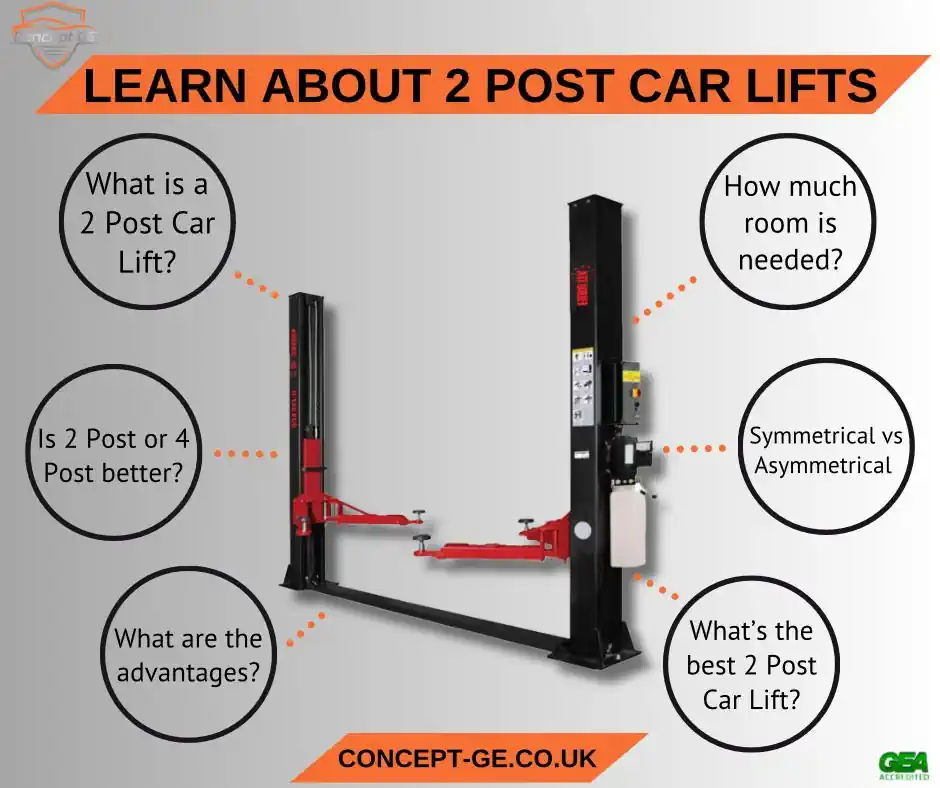2 post lifts are an essential tool in any modern-day garage, tyre shop or MOT Bay to enable work to be carried out on the wheels, as well as the side and underside of a vehicle. There are several varieties of vehicle lifts, but the 2 post lift is one of the most common due to the relatively small space that you need to have one installed, but it will still give you the stability, strength and lifting capacity far exceeding that of mobile or ground-based jacks.
A brief history of two post car lifts
Prior to the invention of the 2 post car lift for garages, mechanics had to either work without any vehicle lifting solution or within an inspection pit or use basic car ramps to access the underside of the vehicle. These solutions were either less convenient or more time-consuming than using modern-day car lifts, and safety was not always built into the lifting solution. The lack of hydraulics and air-powered tools would have made modern lifts and garage operations impossible, even though Blaise Pascal first introduced the idea of how a hydraulic jack would function 17th century (Pascal’s Principle also known as the Transmission of Fluid-pressure Principle), it was not until 1851 that Richard Dudgeon invented the first hydraulic jack and patented it under the name “portable hydraulic press”. Over 70 years later in 1925, the first hydraulic car lift was patented by inventor Peter Lunati. The inspiration came from watching how a barber’s chair operates, and Lunati took this inspiration and applied it to the first vehicle lift. His invention, the Rotary Lift, is still sold today. This first lift was a single post lift that would rotate 360 degrees with the vehicle raised on it, which gave it the name Rotary. Garage and MOT Bay mechanics today have an array of car lifting solutions to lift cars off the ground so that they can access the wheels, side and underside of the vehicle with ease, of which the two post car lift is one of the most popular due to the cost and space-saving aspects of this type of vehicle lift.
What are the 3 types of car lifts?
The three most common types of car lifts are
The most common of these are two post, and four post car lifts.
What is a 2 post car hoist?
The phrase 2-post hoist is often used to describe a 2-post car lift, however, this should not be confused with an engine hoist, crane or lift which is used for removing engines from vehicles.

garage engine crane

car engine hoist

two-post car lift
What is a 2 post car lift?
A 2 post car lift, is a large steel structure, consisting of 2 folded or rolled steel columns, or posts with 2 arms on each post used to raise cars for each access to the wheels, side and underside of the vehicle. Each post contains a motor and these turn large screws inside the columns, each of which has a lifting nut and safety nut at each side. The lift nut is what supports the arms of the 2 post lift, and rollers on either side support a smooth lifting process. The two posts of the car lift are also connected via a set of cables or chains, often referred to as equilibrium cables, which run either above or below between the posts and ensure that each of the 2 post lifting screws are synchronised and that they raise and lower at the same rate, to keep the car being lifted stable, despite any weight differences on the 2 sides of the vehicle.
How does a 2 post lift not fall over?
Two post lifts are anchored to the ground during installation by the use of ground-fixing bolts securely bolted into a solid concrete floor of the correct depth to ensure that the pillars or posts of the lift are firmly fixed in place and unable to move during normal operation of the car lift. There are however some additional measures that must be taken to ensure that the risk of lift failure is prevented, and these are as follows. Before and during the installation of the two post car lift
- ensure the concrete is of suitable depth before installing
- ensure the concrete is level before installing
- buy the correct lift for the vehicles you intend to be lifting
- lift must be professionally installed and tested prior to use
Before the use of the two post car lift
- ensure correct 2 post lift training has been done for you and any staff who will operate the car lift
- perform regular preventative maintenance on the 2 post lift, including a thorough examination of the lift by a competent person or trained garage lift engineer
- ensure the locking mechanism has been tested and working before use
- ensuring the support arm rubber mounts are in a serviceable condition
During the use of the two post car lift
- don’t overload the two post lift
- identify the correct jacking/lifting points for the vehicle
- ensure the car is correctly positioned on the lift
- lift the car slightly from the ground and check that the arms have locked correctly
- check vehicle weight distribution and stability before raising fully
How thick should concrete be for a 2 post car lift?
The minimal concrete depth that we recommend for a two post car lift installation is between 150mm (6 inches) and 250mm (10 inches). Lift manufacturers and several lift installation engineers use the absolute minimum recommended depth of 100mm or 4 inches of concrete, but due to the excessive weight and forces imparted by a 2 post lift at the floor bolts and base, we would always recommend deeper concrete than this. A two post car lift is usually mounted onto an existing concrete surface, though this must be tested and confirmed as both level and of a suitable depth prior to beginning the lift installation. On occasions where the depth of concrete is found to be too thin, not structurally sound, or uneven, the existing floor may need to be dug out and relaid with deeper and correctly levelled concrete to meet the minimum requirements. Your 2 post lift supplier or engineer will be able to test the concrete and advise if the depth and concrete is suitable for the lift you are planning to install. Speak to Concept Garage Equipment as we can help with this prior to any purchase or lift installation taking place.
How often must 2 post car lifts be thoroughly examined?
All two post car lifts must be thoroughly examined by a competent person before they are first used (as per HSE803/69). This could be by the installing garage equipment company for example. A thorough examination of the 2 post car lift is also required following ‘exceptional circumstances, for example, if a lift is damaged following improper use, failing parts that needed to be repaired or replaced, following a lift failure or fall, and following long periods of use. Please note, the thorough examination of a two post car lift is not a replacement for the regular routine maintenance of the lift which must be completed regardless of usage or failure of the vehicle lift. Lift maintenance is required under the Provision and Use of Work Equipment Regulations 1998 and applies to all work equipment including car lifts, and this states: Maintenance 5.—(1) Every employer shall ensure that work equipment is maintained in an efficient state, in efficient working order and in good repair. (2) Every employer shall ensure that where any machinery has a maintenance log, the log is kept up to date.
What are Symmetrical and Asymmetrical 2 Post Car Lifts?
The 2 main types of 2 post car lifts are known as symmetrical and asymmetrical and can be easily identified by examining the length of the 2 arms on each side of the car lift. The symmetrical two post car lift has arms of equal length, and the vehicle sits at the centre equidistant between the 2 arms on each side, and the weight is distributed evenly across the 2 post lifting arms. The asymmetric 2 post car lift has one arm on each side of the lift slightly longer than the other, and this allows you to position the vehicle slightly further back on the 2 post car lift, meaning that most of the vehicle weight is taken on the rear arm on each side of the car lift, the benefit being that it makes it easier to open the doors to access the interior, without impacting the column on that side of the car.
What are the differences between 2 post or 4 post car lifts?
The 4 post car lift has 4 supporting posts or columns, which support 2 ramps or platforms, and it’s upon these platforms that the car will be held whilst the columns raise these into the air. This means that all 4 columns of this type of car lift must be secured to the floor, making the footprint of this kind of car lift white large, and larger still if this is a commercial vehicle lift, and not just for cars. The 2 post lift however only requires 2 posts or columns secured to the ground, each has 2 arms that extend inwards and can be moved into position under a car to meet the best lifting areas of the chassis. These arms come fitted with pads that prevent damage to the underside of the car whilst the arms are lifted into the air, thus raising the vehicle.
Are 2 post or 4 post lifts better?
Both types of car lifts have their benefits, and it often comes down to 5 main factors
- Price
- Lifting Capacity
- Floor Space
- Ceiling Height
- Types of vehicles to work on
If you have plenty of space in your garage or MOT Bay, then the 4 post lift will always be the more stable and secure of these types of car lift, however, this comes at an additional cost, and in general, a 4 post lift will not lift a car as high as a two post lift, due to the fact the platforms hang underneath the lifting arms on a 4 post lift. However a 2 post lift takes up a fraction of the room of its 4 post equivalent, and prices tend to be significantly lower for 2 post car lifts, often half the price for a 2 post car lift in fact. As the 2 post lifts can lift a car higher, you do need to ensure that the ceiling height restrictions are adhered to before committing to the installation of a two post lift. However, for low-profile vehicles, the two post lift is not usually the best option, due to the way the arms of the lift are inserted underneath the car prior to lifting, generally, a specialist low-profile 4-post lift is better for this kind of vehicle lifting.
What are the advantages of a two post lift?
The main advantages of a two post car lift are
- Low price
- Small footprint size
- Arms can be stowed or folded when not in use
- High lifting capacity
- Great all round access around and under the car
- What are the disadvantages of a two post lift?
The main disadvantages of a two post car lift are
- Lifting capacity (applies to some but not all 2 post car lifts)
- Height of the lift posts
- Depth of concrete needed for floor bolt installation
- Unable to work on very low-profile cars
- Unsuitable for use in car MOT
So, what’s better, a 2 or 4 post car lift?
If you want something for a small workshop or home garage, or where size is a restriction then a two post car lift is the better option for you. If you want to work on larger, more specialised vehicles, or low-profile cars, then a 4-post lift would be the better choice. Furthermore, if you have an MOT Bay then a 4 post ATL MOT lift would be necessary for you to meet UK MOT requirements.
Can I install a 2-post car lift in my home garage?
Yes, two post car lifts can be used for home garages either for working on your own vehicles or for storage purposes, however, if you have space we would recommend a four-post lift over a 2-post lift for longer-term storage or storage of heavier cars. They provide stable locking platforms for raising and storing your vehicle, freeing up floor space in your garage. This is particularly useful if you have multiple vehicles or limited parking space. Concept Garage Equipment offers four-post lifts that are particularly suitable for storage applications, ensuring your vehicle remains securely elevated for extended periods if necessary.
How much does a 2 post car lift cost?
There are several costs to consider when purchasing a 2 post lift, these include
- The cost of the 2 post car lift
- The groundwork to prepare the floor and ensure it is both thick, level and solid enough for the 2 post lift installation
- Electrical work to ensure the 1-phase or 3-phase power supply is set up and suitable to supply electricity to the car lift
- Training for you or your staff to ensure they know how to best and most safely use the 2 post lift
- Servicing of the 2 post lift is part of the essential preventative maintenance to ensure the correct operation of the car lift and to prevent breakdowns
Budget 2 post lifts can range from under £2000 to purchase, however, please ensure you have all other items above factored in, and also that the warranty supplied with your 2 post lift is right for you.
How much ceiling height do you need for a 2 post lift?
Generally, to install a standard full-rise 2 post car lift you need a ceiling height of at least 11 feet (or 3400mm). There are 2 post lifts that will work with a lower ceiling height, which are called low-rise or mid-rise lifts, so please be aware of the 2 post car lift you are purchasing and the specific height requirements for it, which you should be able to either see online or by calling Concept Garage Equipment today.
How much does it cost to install a 2 post lift?
The costs to install a 2 post car lift can vary depending on the following factors:
- The type, size, quality and brand of the 2 post lift
- If this is part of a full garage installation or MOT Bay Installation
- Whether this is simply a shipped lift in a carton or includes installation by a trained engineer (which is of course highly recommended)
- Whether any electrical work is required for the 1-phase or 3-phase electric supply to the 2 post car lift
- If this includes a service plan for ongoing maintenance
Please discuss this with Concept Garage Equipment for full details and costs, as this will also differ between makes and models, and we are best placed to advise across the range available on the market today.
Where should a car be placed on a 2-post lift?
The position of a car on a 2 post lift varies depending on the type of 2 post lift being used, there are Symmetrical and Asymmetrical 2 Post Car Lifts, and you need to know which type of two post lift you have before attempting to position or lift a vehicle
Car position on an Asymmetric two post lift

A pillar for 2 post car lift post positioning
As the asymmetric 2-post car lift has one arm on each side of the lift slightly longer than the other, you must position the car such that the lift posts are in line with the “A” pillar – this is the upright pillar at the front of the windscreen which connects between the bodywork and the roof to support the windscreen (see image for details), such that about 30% of the car is in front of the 2 post car lift, and about 70% behind the lift posts. Position each lift pad under the car manufacturer’s recommended lifting points, with the longer of the 2 arms supporting the rear of the car and the shorter arms supporting the front.
Car position on a Symmetric two-post lift
As the symmetrical two post car lift has arms of equal length, the vehicle will sit at the centre equidistant between the 2 arms on each side, hence you must position the car so that both lift posts are in-line with the centre of the vehicle. Position each lift pad under the vehicle manufacturer’s recommended lifting points.
Safety notes before and during 2 post lifting on both Symmetric and Asymmetric two post lifts
Do not use 3rd party blocks or wooden wedges to compensate if the lift pads do not engage properly, you should have suitable replacement lift pads to compensate for any shortfall, but contact your 2 post lift supplier if you do not have these. Always double-check the position of the arms and lifting pads, and also lift the car very slightly from the ground and do a final rock of the vehicle to ensure it is stable before lifting fully.
What 2 Post Lift is best?
There are many 2 post lift manufacturers’ sizes and options on the market today, depending on the needs of your garage, workshop or MOT bay. Two-post car lifts can be used for cars, fit the needs of both short and long-wheelbase vehicles and can be adjusted to the size of the vehicle you are working on. Two-post vehicle lifts are the best option for businesses with a smaller workshop, home garage, or a location where multiple MOT bays or lifts are required within a limited space as they take up less room than a 4 post lift. This type of vehicle lift is a great tool that will help you work on cars, whilst making the best use of your workshop space. So, whether you are a professional technician a hobby mechanic, or just an enthusiastic vehicle owner having a two-post lift will undoubtedly come in handy when servicing and maintaining your cars. That said, it is important to be informed about all the options available to you before you decide which 2 post lifts will work best for you and your requirements. Be sure to be aware of your available space, and assess the size, weight, and type of vehicles you intend to lift. Speak to Concept Garage Equipment to discuss your unique requirements and setup, and we will advise on which two post car lift we feel would suit your setup best.
How far apart should 2 post lifts be?
The recommended minimum distance between two post car lifts is at least two feet or 600mm of space between the base of your car lift posts, as well as at least this between the vehicles that may be lifted on these vehicle lifts. Firstly, for practical purposes, this ensures suitable clearance between lifts that are both side-to-side or installed sequentially in a garage, and that there is ample space to move around between any vehicles that are on the lifts at the same time for working on these. More importantly for Health and safety reasons, 600mm is the minimum clearance that the fire brigade would need to move between vehicles on a lift with full breathing apparatus if the vehicle on the lift happened to be on fire. This stipulation was a result of a risk assessment carried out by the UK fire brigade and must be strictly adhered to, as any insurance claim would be at risk if you have not done so.
How wide does a garage need to be for a 2 post lift?
Similar to the previous question, once you have selected your 2 post car lift, you need to ensure that there is enough room in your garage to have at least two feet or 600mm of space between the base of your car lift and the walls or doors of your garage, as well as at least this same space between the edges of any vehicles that may be lifted on this car lift to enable you to work both around and under the car and that all doors of the garage can be opened and shut completely with no impact risk. This also adhered to health and safety regulations set out by the UK fire brigade, as detailed above. Call Concept Garage Equipment today to arrange an inspection of your premises and suitability for a two-post car lift, as we can advise on all aspects of garage equipment and car lifts for your garage or workshop.
Is it OK to store a car on a 2-post lift?
Although there is no legislative requirement or recommendation on how long a car can stay on a 2 post lift, however, we would recommend that the vehicle only remains on the lift for the duration of the work needed to repair it, and then ideally the car should be removed from the lift to reduce or remove any strain on the lift components, especially the screws, lift nuts and safety nuts. Also, excessive time on the lift may lead to additional maintenance being required on the 2 post lift in the future. An additional word of warning. No vehicle should be parked under a 2 post car lift with either the arms or a vehicle raised above the height of the vehicle, this is preventative to ensure no accidental damage comes to the vehicle below.
What are common problems with a 2 post car lift?
If a two post car lift is properly installed and meticulously maintained there should be no significant problems and the lift should give you excellent service for years to come, however, if it’s problematic here are a few things to check.
- The car lift won’t raise or lower: check the oil levels, and electrical connections, and check screws, chains, ropes and screw nuts for correct operation
- The car lift is operating slower than usual: check hydraulic fluid levels, and check for air or contaminants in the fluid or any otherwise lubricated parts. Check the screw nut and the locking nut for correct operation, or blockages
- A car is stuck on a raised 2 post lift: Do not stand under the lift, but check what you can without endangering yourself or anybody else, including the electric supply, and the hydraulic fluid levels and look for any obvious blockages or broken cables.
We highly recommend if you experience any of the above issues that you contact your lift manufacturer or supplier at the earliest opportunity to have the issue resolved by a professional engineer and remove any risk to yourself, colleagues or vehicles.
What to do if a lift breaks down?
If you experience a catastrophic failure of your two post car lift, and the issue is not something obvious that can be easily resolved with no risk to you or your garage mechanics or vehicles within the workshop, then please contact your lift manufacturer or supplier at the earliest opportunity to have the issue resolved by a professional engineer.
We have engineers available to help with all aspects of lift repairs and can deal with all makes and models of 2 post lifts.
What needs to be inspected regularly on a two-post car lift?
The monthly inspection of your 2 post car lift should include the following checks
- Check that all moving parts are properly lubricated and are not seized including
- Ropes, chains, rollers and carriage pins
- Check that all floor anchor bolts are correctly tightened
- Check that all hydraulic fluid levels are topped up with the correct specified lubricant
- Check that electrical connections are working with no exposed wires
- Check for obstacles, blockages or foreign material near or within any of the moving parts that hinder the correct operation of the 2 post lift
Regular inspection and lift maintenance is required under the Provision and Use of Work Equipment Regulations 1998 and applies to all work equipment including car 2 post lifts.
Before, during, and particularly after a long period of not being used, all lifts need to be checked to ensure no damage has been done, and that all parts are operating properly before using the lift to raise or lower a vehicle, this helps to ensure the lift is being maintained correctly and also helps address any safety concerns before they ever become an issue.
We supply Garage Equipment from every major garage equipment manufacturer and have a vast array of engineers across the UK who can service any vehicle lifting equipment you have, regardless of whether or not you purchased this from Concept Garage Equipment.
Help with your two post car lift
If you are considering or even in the process of purchasing or setting up a two post car lift, or indeed any other type of vehicle lift, either as a stand-alone piece of garage equipment or as part of an MOT Bay build and need some information, helpful free advice or additional garage or MOT equipment give Concept Garage Equipment a call, we would love to help you get your garage equipment set up and paying for itself as soon as possible. We can offer you advice over the phone at 0113 469 0572, we sell 2 post car lifts online and over the phone, including delivery, installation and staff training in the correct use of the two post car lift or any other garage equipment up to a full MOT Bay. Call us today on 0113 469 0572 or use the website contact form today, we are here to help.

Symmetrical two-post car lift

Asymmetric 2-post car lift


